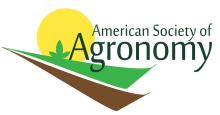Resource information
Near infrared reflectance spectroscopy (NIRS) has potential to provide timely, and lower cost estimates of soil properties than current laboratory techniques. This study defined the capacity of NIRS to predict soil organic matter (SOM), total carbon (TC) and total nitrogen (TN) in native prairie (n = 3) and conventionally tilled wheat (n = 1) experimental paddocks (1.6 ha) in central Oklahoma under different forms of long-term (1978-2004) management. Samples were collected from paddocks along 150-m transects situated between a ridge and toe slope. The A horizon was divided into sections (0- 5, 5-10, and 10-25 cm), reflectance (R) measurements (log 1/R) collected, and absorption spectra (750-2500 nm) developed for random samples collected from all paddocks (total n = 124 for C and N; n = 214 for SOM). Calibration equations between absorbance at various wavelengths and laboratory-measured properties were developed by multivariate partial least squares regression, and tested with an independent validation set of observations. Relationship between laboratory values and NIRS estimates (n = 62 for C and N; n = 75 for SOM) generated significant calibration equations (0.91



